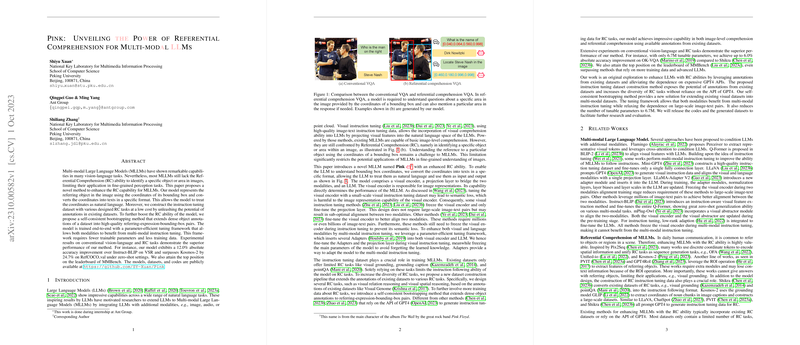Enhancing Fine-Grained Image Understanding in Multi-Modal LLMs Through Referential Comprehension
The paper "Pink: Unveiling the Power of Referential Comprehension for Multi-modal LLMs" presents a novel approach to enhance the fine-grained image understanding abilities of Multi-Modal LLMs (MLLMs). Despite the capabilities of MLLMs in various multi-modal tasks, their performance in tasks requiring detailed image understanding has been suboptimal. The proposed framework seeks to address this challenge by incorporating referential comprehension (RC) tasks into the instruction tuning phase, allowing MLLMs to better interpret fine-grained visual elements.
Methodology Overview
The core of the proposed framework includes a sophisticated dataset construction method and an efficient strategy to adjust the visual encoder during instruction tuning:
- Dataset Construction: The paper introduces a cost-effective approach to build a comprehensive instruction tuning dataset by leveraging annotations from existing datasets. This method allows the creation of high-quality instruction data essential for enhancing MLLMs' abilities in detailed image perception. The authors have ingeniously devised methods to extend dense object annotations into referring-expression-bounding-box pairs, thereby enriching the dataset with tasks that cover fundamental abilities such as visual relation reasoning, spatial reasoning, object counting, and object detection.
- Self-Consistent Bootstrapping: A novel method termed "self-consistent bootstrapping" is utilized to ensure the accuracy and quality of generated data. This method leverages the capabilities of MLLMs to extend existing dense annotations into high-quality RC data, enabling the generation of varied instruction-following datasets efficiently.
- Visual Encoder Tuning: The research emphasizes the need to tune the visual encoder during instruction tuning. By introducing adaptable components such as Adapters and LoRA, the methodology prevents semantic loss and advances the ability of the visual encoder to perform detailed image understanding without necessitating extensive datasets or computation resources.
Experimental Validation
The proposed model, named "Pink," undergoes exhaustive experimentation, demonstrating its superior performance against existing methods, especially in RC tasks. It exhibits notable accuracy improvements of 5.2% over Qwen-VL on the GQA benchmark and an impressive 24.7% accuracy gain over Kosmos-2 on the RefCOCO_val dataset. The model also secures the top position on the MMBench leaderboard. This was achieved using publicly accessible data and maintaining a smaller set of trainable parameters (6.7M), highlighting the efficiency and reproducibility of the framework.
Implications and Future Directions
The paper makes significant contributions to the field of AI and multi-modal learning by paving the way for more nuanced visual understanding through MLLMs. The method's reliance on publicly available datasets and its adaptability for use on consumer-grade GPUs underscore its potential for widespread academic application and replication.
In terms of future developments, the research suggests the utility of expanding RC task diversity further, which could enhance the model’s ability to generalize across various tasks. Additionally, exploring more advanced fine-tuning techniques, perhaps integrating more sophisticated components within the visual encoder, could yield even finer granularity in image understanding tasks.
Overall, the paper provides a valuable framework that not only enhances the capacity of current MLLMs but also offers insights into efficiently optimizing vision-LLMs for more detailed comprehension tasks without excessive resource demands.
